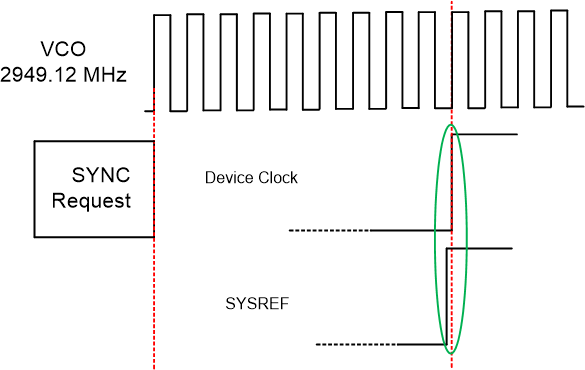SNAS698C May 2020 – November 2022 LMK04832-SP
PRODUCTION DATA
- 1 Features
- 2 Applications
- 3 Description
- 4 Revision History
- 5 Pin Configuration and Functions
- 6 Specifications
- 7 Parameter Measurement Information
-
8 Detailed Description
- 8.1 Overview
- 8.2 Functional Block Diagram
- 8.3 Feature Description
- 8.4 Device Functional Modes
- 8.5 Programming
- 8.6
Register Maps
- 8.6.1 Register Map for Device Programming
- 8.6.2
Device Register Descriptions
- 8.6.2.1 System Functions
- 8.6.2.2
(0x100 - 0x138) Device Clock and SYSREF Clock Output Controls
- 8.6.2.2.1 DCLKX_Y_DIV
- 8.6.2.2.2 DCLKX_Y_DDLY
- 8.6.2.2.3 CLKoutX_Y_PD, CLKoutX_Y_ODL, CLKoutX_Y_IDL, DCLKX_Y_DDLY_PD, DCLKX_Y_DDLY[9:8], DCLKX_Y_DIV[9:8]
- 8.6.2.2.4 CLKoutX_SRC_MUX, CLKoutX_Y_PD, DCLKX_Y_BYP, DCLKX_Y_DCC, DCLKX_Y_POL, DCLKX_Y_HS
- 8.6.2.2.5 CLKoutY_SRC_MUX, SCLKX_Y_PD, SCLKX_Y_DIS_MODE, SCLKX_Y_POL, SCLKX_Y_HS
- 8.6.2.2.6 SCLKX_Y_ADLY_EN, SCLKX_Y_ADLY
- 8.6.2.2.7 SCLKX_Y_DDLY
- 8.6.2.2.8 CLKoutY_FMT, CLKoutX_FMT
- 8.6.2.3
SYSREF, SYNC, and Device Config
- 8.6.2.3.1 VCO_MUX, OSCout_MUX, OSCout_FMT
- 8.6.2.3.2 SYSREF_REQ_EN, SYNC_BYPASS, SYSREF_MUX
- 8.6.2.3.3 SYSREF_DIV
- 8.6.2.3.4 SYSREF_DDLY
- 8.6.2.3.5 SYSREF_PULSE_CNT
- 8.6.2.3.6 PLL2_RCLK_MUX, PLL2_NCLK_MUX, PLL1_NCLK_MUX, FB_MUX, FB_MUX_EN
- 8.6.2.3.7 PLL1_PD, VCO_LDO_PD, VCO_PD, OSCin_PD, SYSREF_GBL_PD, SYSREF_PD, SYSREF_DDLY_PD, SYSREF_PLSR_PD
- 8.6.2.3.8 DDLYdSYSREF_EN, DDLYdX_EN
- 8.6.2.3.9 DDLYd_STEP_CNT
- 8.6.2.3.10 SYSREF_CLR, SYNC_1SHOT_EN, SYNC_POL, SYNC_EN, SYNC_PLL2_DLD, SYNC_PLL1_DLD, SYNC_MODE
- 8.6.2.3.11 SYNC_DISSYSREF, SYNC_DISX
- 8.6.2.3.12 PLL1R_SYNC_EN, PLL1R_SYNC_SRC, PLL2R_SYNC_EN, FIN0_DIV2_EN, FIN0_INPUT_TYPE
- 8.6.2.4
(0x146 - 0x149) CLKin Control
- 8.6.2.4.1 CLKin_SEL_PIN_EN, CLKin_SEL_PIN_POL, CLKin2_EN, CLKin1_EN, CLKin0_EN, CLKin2_TYPE, CLKin1_TYPE, CLKin0_TYPE
- 8.6.2.4.2 CLKin_SEL_AUTO_REVERT_EN, CLKin_SEL_AUTO_EN, CLKin_SEL_MANUAL, CLKin1_DEMUX, CLKin0_DEMUX
- 8.6.2.4.3 CLKin_SEL0_MUX, CLKin_SEL0_TYPE
- 8.6.2.4.4 SDIO_RDBK_TYPE, CLKin_SEL1_MUX, CLKin_SEL1_TYPE
- 8.6.2.5 RESET_MUX, RESET_TYPE
- 8.6.2.6
(0x14B - 0x152) Holdover
- 8.6.2.6.1 LOS_TIMEOUT, LOS_EN, TRACK_EN, HOLDOVER_FORCE, MAN_DAC_EN, MAN_DAC[9:8]
- 8.6.2.6.2 MAN_DAC
- 8.6.2.6.3 DAC_TRIP_LOW
- 8.6.2.6.4 DAC_CLK_MULT, DAC_TRIP_HIGH
- 8.6.2.6.5 DAC_CLK_CNTR
- 8.6.2.6.6 CLKin_OVERRIDE, HOLDOVER_EXIT_MODE, HOLDOVER_PLL1_DET, LOS_EXTERNAL_INPUT, HOLDOVER_VTUNE_DET, CLKin_SWITCH_CP_TRI, HOLDOVER_EN
- 8.6.2.6.7 HOLDOVER_DLD_CNT
- 8.6.2.7 (0x153 - 0x15F) PLL1 Configuration
- 8.6.2.8 (0x160 - 0x16E) PLL2 Configuration
- 8.6.2.9 (0x16F - 0x555) Misc Registers
- 9 Application and Implementation
- 10Device and Documentation Support
- 11Mechanical, Packaging, and Orderable Information
Package Options
Mechanical Data (Package|Pins)
- HBE|64
Thermal pad, mechanical data (Package|Pins)
Orderable Information
8.3.5 SYSREF to Device Clock Alignment
To ensure proper JESD204B operation, the timing relationship between the SYSREF and the Device clock must be adjusted for optimum setup and hold time as shown in Figure 8-6. The global SYSREF digital delay (SYSREF_DDLY), local SYSREF digital delay (SCLKX_Y_DDLY), local SYSREF half step (SCLKX_Y_HS), and local SYSREF analog delay (SCLKX_Y_ADLY, SCLK2_3_ADLY_EN) can be adjusted to provide the required setup and hold time between SYSREF and Device Clock. It is also possible to adjust the device clock digital delay (DCLKX_Y_DDLY) and half step (DCLK0_1_HS, DCLK0_1_DCC) to adjust phase with respect to SYSREF.
 Figure 8-6 SYSREF to Device Clock Timing
alignment
Figure 8-6 SYSREF to Device Clock Timing
alignmentDepending on the DCLKout_X path settings, local SCLK_X_Y_DDLY might need adjustment factor. Following equation can be used to calculate the required Digital Delay Values to align SYSREF to the corresponding DCLKout:
SYSREF_DDLY > 7; SCLK_X_Y_DDLY > 1.
| DCLK & HS | DCLK_HS_ADJUST |
|---|---|
| 0 | 0 |
| 1 | 1 |
For example: DCLKX_Y_DIV = 32, DCLKX_Y_DDLY = 10, DCC&HS = 1;
SYSREF_DDLY=10 – 1 + 0 + 1 – 2 = 8